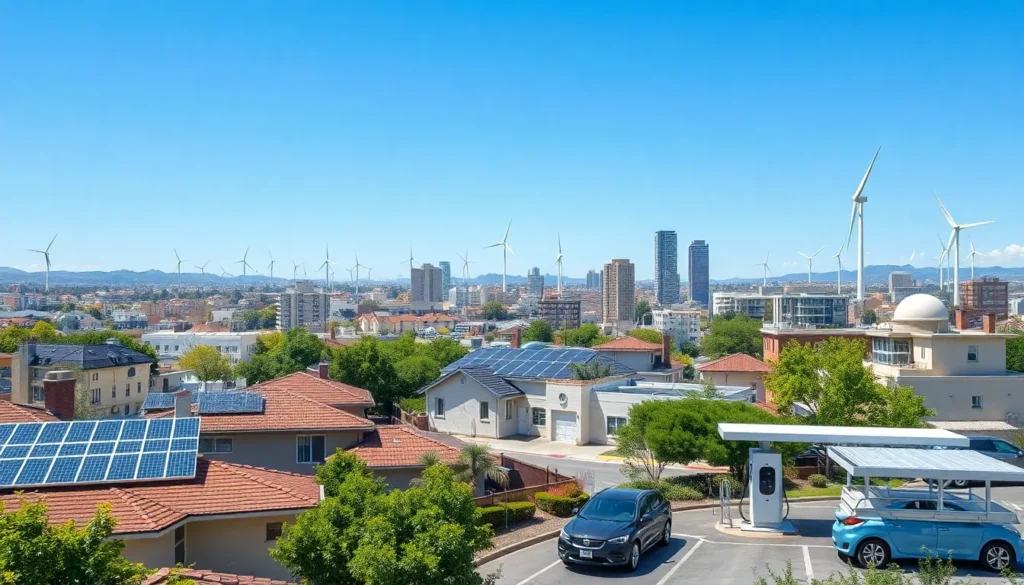Table of Contents
ToggleAs the world grapples with the pressing challenge of climate change, carbon-efficient technology emerges as a beacon of hope. This innovative approach not only aims to reduce greenhouse gas emissions but also enhances energy efficiency across various sectors. With businesses and governments seeking sustainable solutions, the demand for these technologies is growing rapidly.
Carbon-efficient technology encompasses a range of advancements, from renewable energy sources to smart grids and energy-efficient appliances. By adopting these solutions, society can significantly lessen its carbon footprint while fostering economic growth. Understanding the potential of these technologies is crucial for shaping a sustainable future and combating climate change effectively.
Overview of Carbon-efficient Technology
Carbon-efficient technology encompasses innovations specifically designed to minimize greenhouse gas emissions while optimizing energy use. These technologies play a crucial role in various sectors, including transportation, manufacturing, and energy production. By improving energy efficiency and utilizing renewable energy sources, these advancements significantly lower overall carbon footprints.
Key elements of carbon-efficient technology include:
- Renewable Energy Sources
Renewable energy sources, such as solar panels and wind turbines, generate electricity without emitting greenhouse gases, supporting a sustainable transition from fossil fuels.
- Energy Storage Solutions
Energy storage technologies, like batteries, enable the efficient use of renewable energy by storing surplus power generated during peak production times for later use.
- Smart Grids
Smart grids enhance electricity distribution by optimizing the use of resources, reducing waste, and allowing for real-time monitoring and control of energy consumption.
- Electric Vehicles (EVs)
Electric vehicles reduce reliance on gasoline and diesel, contributing to lower emissions, especially when charged using renewable energy.
- Carbon Capture and Storage (CCS)
CCS technologies capture carbon dioxide emissions from industrial processes and store them underground, preventing them from entering the atmosphere.
- Energy-efficient Appliances
Energy-efficient appliances consume less energy compared to traditional models, resulting in reductions in emissions associated with energy production.
Through these technologies, businesses and governments can drive sustainability efforts and pave the way for a lower carbon future. The integration of carbon-efficient technology not only supports environmental goals but also fosters economic growth by creating new markets and job opportunities. Understanding and adopting these innovations is vital for addressing global challenges related to climate change.
Benefits of Carbon-efficient Technology

Carbon-efficient technology offers significant advantages, addressing both environmental and economic concerns. Its adoption leads to reduced greenhouse gas emissions and enhanced resource management.
Environmental Impact
Carbon-efficient technology plays a critical role in mitigating climate change. It decreases reliance on fossil fuels by promoting renewable energy sources, resulting in lower carbon dioxide (CO2) emissions. For instance, solar panels and wind turbines can cut emissions by up to 80% in energy production compared to traditional power plants. Additionally, integrating energy-efficient appliances can reduce energy consumption in homes and businesses by 15-50%, contributing to overall carbon footprint reduction. These advancements not only preserve natural ecosystems but also enhance air quality, benefiting public health and biodiversity.
Economic Advantages
Carbon-efficient technology presents substantial economic benefits. Shifting to renewable energy reduces energy costs over time, as sources like solar and wind become more prevalent and cost-effective. Studies indicate businesses can save up to 30% on energy expenses by implementing energy-efficient systems. Furthermore, investments in carbon-efficient technologies can create millions of jobs in fields such as manufacturing, installation, and maintenance. Governments that support these initiatives can stimulate economic growth, attract investments, and enhance energy security.
Key Innovations in Carbon-efficient Technology
Carbon-efficient technology encompasses several innovations aimed at reducing emissions and enhancing energy use. Key advancements include renewable energy solutions and energy storage systems.
Renewable Energy Solutions
Renewable energy solutions, such as solar panels and wind turbines, serve as critical components in minimizing carbon footprints. Solar panels convert sunlight into electricity, achieving efficiencies of up to 22%, while wind turbines can harness wind energy with capacities exceeding 10 megawatts. Additionally, geothermal and hydropower systems offer alternative means to generate clean energy, further reducing reliance on fossil fuels. Countries implementing significant renewable energy strategies, like Germany and Denmark, have demonstrated reductions in carbon emissions by over 30% in recent years.
Energy Storage Advancements
Energy storage advancements enhance the effectiveness of renewable energy systems. Batteries, particularly lithium-ion variants, allow for energy capture and release, facilitating a balanced energy supply. Current technologies achieve energy densities of 250 Wh/kg, capable of powering electric vehicles (EVs) for over 300 miles on a single charge. Innovative battery technologies, including solid-state and flow batteries, promise even greater efficiencies and longer lifespans. Moreover, pumped hydro storage and compressed air energy storage (CAES) systems provide large-scale storage solutions to support grid stability. These storage innovations significantly minimize reliance on fossil fuel-based power during peak demand periods.
Challenges in Adoption
Adoption of carbon-efficient technology faces several significant challenges that hinder widespread implementation. Key barriers include financial constraints and technological limitations that impact various sectors.
Financial Barriers
Financial barriers significantly impede the adoption of carbon-efficient technologies. High initial investment costs can deter businesses and governments from transitioning to sustainable solutions. For example, the installation of solar panels or wind turbines often involves substantial capital expenditures, which presents a challenge for cash-strapped organizations. Additionally, access to funding remains uneven, with smaller enterprises facing difficulties in securing loans or grants. A recent report indicates that countries with robust financial incentives for renewable energy technologies experience up to 50% greater adoption rates compared to those without such support. The absence of clear economic benefits in the short term further complicates investment decisions.
Technological Limitations
Technological limitations also pose challenges to the adoption of carbon-efficient solutions. Existing infrastructures may not fully support the integration of new technologies, such as electric vehicles (EVs) and energy storage systems. For instance, inadequate charging station networks can dissuade potential EV users, hindering market growth. Additionally, many carbon capture and storage (CCS) technologies still require further development to achieve efficiency and cost-effectiveness. Research shows that while advancements are underway, implementation timelines can exceed a decade, creating uncertainty for stakeholders. The lack of standardization in technology can also lead to compatibility issues within existing systems, complicating the transition toward more sustainable practices.
Future Trends in Carbon-efficient Technology
Advancements in carbon-efficient technology are continually evolving, shaping a sustainable future. Prominent trends include:
- Increased Adoption of Renewable Energy
Countries aim to enhance renewable energy sources, particularly solar and wind. Data indicate that global solar capacity reached 1,000 gigawatts in 2020, marking a 22% increase from 2019. This growth signals a shift toward sustainable energy infrastructures.
- Enhancements in Energy Storage Solutions
Energy storage technologies, especially lithium-ion batteries, are witnessing rapid advancements. With costs declining by over 80% since 2010, these batteries become increasingly viable for stabilizing renewable energy output and supporting electric vehicle infrastructure.
- Integration of Smart Grids
Smart grid technologies allow for efficient energy distribution and real-time electricity management. By leveraging data analytics, these systems optimize energy consumption patterns, leading to reduced wastage and enhanced grid resilience.
- Development of Carbon Capture Technologies
Carbon capture and storage (CCS) technologies are progressing steadily, with projects capturing millions of tons of CO2 annually. Innovations aim to enhance capture efficiencies, making them essential for achieving climate targets.
- Expansion of Electric Vehicle (EV) Infrastructure
Increased investment in EV infrastructure is apparent, with over 1.8 million public charging points available worldwide as of 2021. This expansion supports the transition to electric mobility, directly contributing to reduced greenhouse gas emissions.
- Circular Economy Initiatives
Companies increasingly adopt circular economy principles, aiming to minimize waste and enhance resource efficiency. By designing products for reuse and recycling, businesses reduce their carbon footprint while conserving materials.
- Government Policy and Incentives
Governments are implementing policies to promote carbon-efficient technologies. Tax incentives, grants, and subsidies support businesses transitioning to renewable energy solutions, aligning economic growth with sustainability goals.
- Emergence of Green Finance
Green finance is gaining traction, with global green bond issuances exceeding $300 billion in 2020. This financial strategy directs funds toward sustainable projects, providing critical financing for carbon-efficient innovations.
These trends indicate a robust commitment to innovative solutions in carbon-efficient technology, essential for addressing climate change effectively. As these advancements shape the future landscape, businesses and governments remain focused on sustainable development.
Carbon-efficient technology stands at the forefront of the fight against climate change. Its ability to reduce greenhouse gas emissions while enhancing energy efficiency makes it indispensable for a sustainable future. As innovation continues to drive advancements in renewable energy and energy storage, the potential for economic growth and job creation becomes increasingly evident.
The challenges in adoption are significant but not insurmountable. With ongoing support from governments and businesses, the transition to these technologies can accelerate. Embracing carbon-efficient solutions not only addresses environmental concerns but also fosters resilience in the economy. The commitment to sustainability through these innovations is crucial for ensuring a healthier planet for generations to come.







